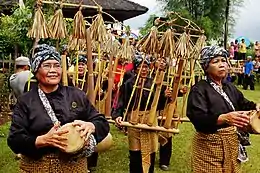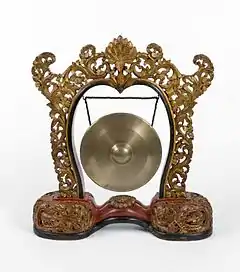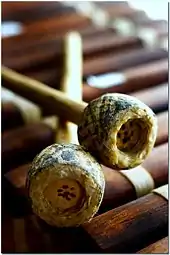Angklung
The angklung (Sundanese: ᮃᮀᮊᮣᮥᮀ) is a musical instrument from West Java, Indonesia made of a varying number of bamboo tubes attached to a bamboo frame.[1] The tubes are carved to have a resonant pitch when struck and are tuned to octaves, similar to Western handbells. The base of the frame is held in one hand, while the other hand shakes the instrument, causing a repeating note to sound. Each performer in an angklung ensemble is typically responsible for just one pitch, sounding their individual angklung at the appropriate times to produce complete melodies (see Kotekan). The angklung is popular throughout the world, but it originated in what is now West Java and Banten provinces in Indonesia, and has been played by the Sundanese for many centuries. The angklung and its music have become an important part of the cultural identity of Sundanese communities in West Java and Banten.[2] Playing the angklung as an orchestra requires cooperation and coordination, and is believed to promote the values of teamwork, mutual respect and social harmony.[3]
| Angklung | |
|---|---|
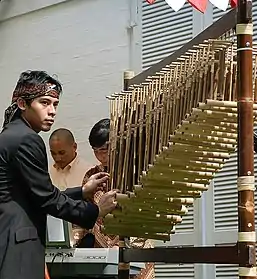 | |
| Country | Indonesia |
| Criteria | Oral Tradition and Expression, Performing Arts, Customs, rituals and celebrations, Knowledge and practices based upon nature and the universe, and Skill in traditional handcraft |
| Reference | 393 |
| Region | Asia and the Pacific |
| Inscription history | |
| Inscription | 2010 (5th session) |
| List | Representative List |
 Traditional Angklung (Pentatonic – Slendro Scale: Angklung Kanekes, Angklung Dogdog Lojor, Angklung Gabrag, Angklung Badeng, Angklung Bungko, Angklung Badud, Angklung Buncis, and angklung Calung) and Modern Angklung (Diatonic/Chromatic - Slendro, Pelog, and Madenda Scale: Angklung Padaeng) | |
 Angklung with eight pitches | |
| Percussion instrument | |
|---|---|
| Classification | Idiophone |
| Hornbostel–Sachs classification | 111.232 (Sets of percussion tubes) |
| Developed | Indonesia |
| Music of Indonesia | |
|---|---|
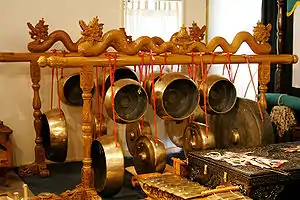 | |
| Genres | |
| |
| Specific forms | |
| |
| Regional music | |
On November 18, 2010, UNESCO officially recognized the Indonesian angklung as a Masterpiece of the Oral and Intangible Heritage of Humanity, and encouraged the Indonesian people and the Indonesian government to safeguard, transmit, promote performances and to encourage the craftsmanship of the angklung.[3]
Etymology
The word angklung may have originated from Sundanese "angkleung-angkleungan", suggesting the movement of the angklung player and the "klung" sound that comes from the instrument.[4] Another theory suggests that the word angklung was formed from two Balinese words – angka and lung. Angka means "tone", and lung means "broken" or "lost". Angklung thus means "incomplete tone".[4]
History
According to Dr. Groneman, the angklung had already been a favorite musical instrument of the entire archipelago even before the Hindu era. According to Jaap Kunst in Music in Java, besides West Java, angklung also exists in South Sumatra and Kalimantan. Lampung, East Java and Central Java are also familiar with the instrument.[4]
In the Hindu period and the time of the Kingdom of Sunda, the instrument played an important role in ceremonies. The angklung was played to honor Dewi Sri, the goddess of fertility, so she would bless their land and lives.[5] The angklung also signaled the time for prayers, and was said to have been played since the 7th century in the Kingdom of Sunda. In the Kingdom of Sunda, it provided martial music during the Battle of Bubat, as told in the Kidung Sunda.[6] The oldest surviving angklung is the Angklung Gubrag, made in the 17th century in Jasinga, Bogor. Other antique angklung are stored in the Sri Baduga Museum, Bandung.[6] The oldest angklung tradition is called angklung buhun (Sundanese: "ancient angklung") from Lebak Regency, Banten.[7] The angklung buhun is an ancient type of angklung played by Baduy people of the inland Banten province during the seren taun harvest ceremony.
In 1938, Daeng Soetigna (Sutigna), from Bandung, created an angklung that is based on the diatonic scale instead of the traditional pélog or sléndro scales. Since then, the angklung has returned to popularity and is used for education and entertainment, and may even accompany Western instruments in an orchestra. One of the first performances of angklung in an orchestra was in 1955 during the Bandung Conference. In 1966 Udjo Ngalagena, a student of Daeng Soetigna, opened his Saung Angklung ("House of Angklung") as a centre for its preservation and development.[6]
UNESCO designated the angklung a Masterpiece of the Oral and Intangible Heritage of Humanity on November 18, 2010.[8]
%252C_c._1816_-_c._1846.jpg.webp) An illustration of a Baduy man playing a calung by Jannes Theodorus Bik, c. 1816–1846.
An illustration of a Baduy man playing a calung by Jannes Theodorus Bik, c. 1816–1846.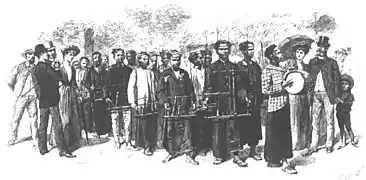 Angklung players in West Java by French illustrator Émile Bayard (1837-1891).
Angklung players in West Java by French illustrator Émile Bayard (1837-1891).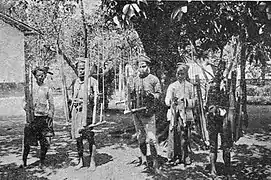
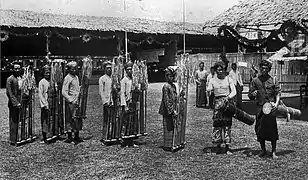 Angklung performance in Batavia (now Jakarta), c. 1910–1930.
Angklung performance in Batavia (now Jakarta), c. 1910–1930.
Varieties
Angklung Kanekes
Angklung kanekes or Angklung Buhun or Angklung Baduy is an ancient angklung originating from the Baduy in Lebak, the Banten province of Indonesia. This angklung is used to accompany the ritual of planting rice on the fields passed down by their ancestors. Angklung kanekes are only made by the Baduy Dalam tribe who still maintain the pure traditions of their ancestors. The names of angklung music instruments in Kanekes from the biggest are: indung, ringkung, dongdong, gunjing, engklok, indung leutik, torolok, and roel.[9]
Angklung Dogdog Lojor
Angklung Dogdog Lojor is an angklung that originates from the dogdog lojor culture found in the Kasepuhan Pancer Pangawinan community or Kesatuan Banten Kidul that scattered around Mount Halimun. Angklung dogdog lojor is used to accompany the tradition of farming, circumcision, and marriage. This angklung is played by 6 players consisting of 2 players playing angklung dogdog lojor and 4 players playing large angklung.[9][10]
Angklung Gabrag
Angklung Gabrag is an angklung originating from Cipinang village, Cigudeg, Bogor, West Java. This angklung is very old and is used to honor the goddess of rice, Dewi Sri. Angklung is played when melak pare (planting rice), ngunjal pare (jammed), and ngadiukeun (placing) into the leuit (barn). In the myth, Gubrag angklung began to exist when Cipining village experienced a dry season, because Dewi Sri did not make it rain.[9]
Angklung Badeng
Angklung Badeng is an angklung originating from Garut, West Java. Initially, this angklung was used for the ritual of planting rice, but now it has shifted to be used to accompany the preaching of Islam. It takes 9 angklung to complete the da'wah accompaniment process consisting of two angklung roel, one angklung kecer, four angklung indung, two angklung anak, two angklung dogdogs, and two gembyung.[10]
Angklung Bungko

Angklung Bungko is an angklung that originates from the arts in Bungko village, Cirebon, West Java. Angklung Bungko is played with other musical instruments such as kendang, tutukan, klenong and gongs. In ancient times, angklung Bungko was a musical accompaniment to fights between villagers. The existing Angklung Bungko consists of three pieces which are believed to be 600 years old. This old angklung is believed to have originated from Ki Gede Bungko, the elder of Bungko Village, as well as the Commander of the Navy of the Cirebon Sultanate in the Sunan Gunung Jati era around the 15th century. Now, this angklung cannot be played anymore because it is fragile. The people believe that angklung bungko has magical powers. In ancient times, if a child was sick, when this angklung bungko was played around the village and accompanied by a dance, the child could recover on its own.[11]
Angklung Badud
Angklung Badud is a type of angklung that is used for performing arts at parades or carnivals. The art of Badud Angklung was born and preserved in Parakanhonje Village, Indihiang District, Tasikmalaya City, West Java. Under the care of the Kanca Indihiang Big Family, angklung badud in its era around the 70s can be known everywhere. The main function of Angklung badud in society is to parade and entertain children before circumcision. In ancient times when local anesthetics had not been used When circumcision, the child who was going to be circumcised early in the morning was paraded to the pool (balong). Then, the child soaks in the pool for a few minutes, on the way to and from the pool, Angklung badud is played. The people also flock to form a line-up, like a parade or a carnival now.[12]
Angklung Buncis
Angklung Buncis is angklung that used for entertainment performance, among them are angklung in the Baros area, Arjasari, Bandung, West Java. The instruments used in the art of angklung buncis are 2 angklung indung, 2 angklung ambrug, angklung panempas, 2 angklung pancer, 1 angklung enclok, 3 dogdogs (1 talingtit, 1 panunggung, and 1 badublag). In its development then added with tarompet, kecrek, and gongs. The angklung buncis has a salendro tone and a vocal song can be madenda or degung.[13]
Initially, angklung buncis was used in agricultural events related to rice. But nowadays, angklung buncis is used as an art of entertainment. This is related to the changing view of society which begins to pay less attention to old beliefs. The 1940s can be considered as the end of the ritual function of angklung buncis in honor of rice because since then it turned into an entertainment show. In addition, rice storage places (leuit; barns) began to disappear from people's homes, replaced by sack places that were more practical and easy to carry anywhere. Many of the rice is now sold directly, not stored in barns. Thus the art of angklung buncis that were used for ngunjal (carrying rice) ritual is no longer needed. The name of the angklung buncis is related to a song text that is well known among the people, namely "cis kacang buncis nyengcle ...", and so on. The text is contained in the art of angklung buncis, so this art is called buncis.[14]
Angklung Calung
Angklung calung or calung is a prototype musical instrument made of bamboo. In contrast to the angklung which is played by shaking, calung is played by hitting the rods (wilahan, bilah) of sections of bamboo tubes arranged according to titi laras (scales ) pentatonic (da-mi-na-ti-la). Most types of bamboo for making calung are awi wulung (black bamboo), but some are made from awi temen (white bamboo).
The meaning of calung apart from being a musical instrument is also attached to the term performing art. There are two known forms of calung Sunda, namely calung rantay and calung jinjing. This musical instrument is a traditional Sundanese musical instrument, which is also known and developed in the Banyumas region. When playing the calung rantay the player usually plays the calung rantay by sitting cross-legged while the player calung jinjing carries the bamboo that has been lined up and plays it while standing. Initially, calung was performed to accompany Sundanese traditional ceremonies as a ritual for the celebration of the people of West Java, but with the development of the calung era, it changed its function to a musical instrument that entertained the community by producing beautiful harmony.[15]
Angklung Padaeng
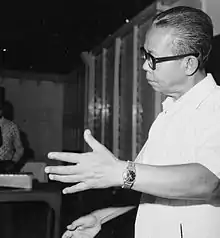
Angklung Padaeng is a musical instrument made of bamboo which is a modern variant of Angklung. Traditional angklung used the slendro, pelog, and madenda scales. In 1938, Daeng Soetigna made an innovation so that angklung could play diatonic notes. To appreciate his work, this diatonic angklung was named angklung padaeng. Angklung Padaeng comes from the words Pak (father, respected adult male) and Daeng (name of the creator of the diatonic angklung). This angklung padaeng innovation is found in the tuning used, which is diatonic which is in accordance with the western music system and can even be presented in an orchestral form.[9]
In line with music theory, the Angklung Padaeng is specifically divided into two groups, namely: the melodic angklung and the akompanimen angklung. A melody angklung specifically consists of two sound tubes with a pitch difference of 1 octave. In one angklung unit, generally, there are 31 small melodic angklung and 11 large melodic angklung. Meanwhile, the akompanimen angklung is the angklung that is used as an accompaniment to play harmonic tones. The voice tube consists of 3 to 4, according to a diatonic chord. After Daeng Soetigna's innovation, other reforms to angklung continued to develop. Some of them are Sarinande Angklung, Arumba, Toel Angklung, and Sri Murni Angklung. After Daeng Soetigna, one of his students, Udjo Ngalagena, continued the Guru's efforts to popularize his invented Angklung, by establishing "Saung Angklung" in the Bandung area. Until this day, the place that has become known as "Saung Angklung Udjo" is still a center of creativity with regard to Angklung.
.jpg.webp) Angklung display.
Angklung display.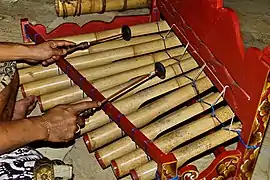

Balinese gamelan angklung
%252C_2015-05-21.jpg.webp)
In Bali, an ensemble of angklung is called a gamelan angklung. While the ensemble gets its name from the bamboo shakers, they are nowadays rarely included outside of East Bali. An ensemble of mostly bronze metallophones is used instead, generally with about 20 musicians.
While the instrumentation of the gamelan angklung is similar to gamelan gong kebyar, there are several critical differences. The instruments in the gamelan angklung are tuned to a 5-tone slendro scale, although most ensembles use a four-tone mode of the five-tone scale played on instruments with four keys. An exception is the five-tone angklung from the north of Bali, which may have as many as seven keys.[16] In four-tone angklung groups, the flute players will occasionally use an implied fifth tone. Additionally, whereas many of the instruments in gong kebyar span multiple octaves of its pentatonic scale, most gamelan angklung instruments only contain one octave, although some five-tone ensembles have roughly an octave and a half. The instruments are considerably smaller than those of the gong kebyar.
Gamelan angklung is heard in Balinese temples, where it supplies musical accompaniment to temple anniversaries (odalan). It is also characteristic of rituals related to death (pitra yadnya), and is therefore connected in Balinese culture to the invisible spiritual realm and transitions from life to death and beyond. Because of their portability, gamelan angklung instruments may be carried in processions while a funeral bier is carried from temporary burial in a cemetery to the cremation site. The musicians also often play music to accompany the cremation ceremony. Thus, many Balinese listeners associate angklung music and its slendro scale with strong emotions evoking a combination of sacred sweetness and sadness.
The structure of the music is similar to gong kebyar, although employing a four-tone scale. A pair of jegog metallophones carries the basic melody, which is elaborated by gangsa, reyong, ceng-ceng, flute, and small drums played with mallets. A medium-sized gong, called kempur, is generally used to punctuate a piece's major sections.
Most older compositions do not employ gong kebyar's more ostentatious virtuosity and showmanship. Recently, many Balinese composers have created kebyar-style works for gamelan angklung or have rearranged kebyar melodies to fit the angklung's more restricted four-tone scale. These new pieces often feature dance, so the gamelan angklung is augmented with heavier gongs and larger drums. Additionally, some modern composers have created experimental instrumental pieces for the gamelan angklung.
Outside Indonesia
The angklung was first invented in West Java, Indonesia, with a possibility of cultural transmittance to various other places such as Malaysia and the Philippines over the course of several centuries. In the early 20th century during the time of the Dutch East Indies, the angklung was adopted in Thailand, where it is called angkalung (อังกะลุง). It was recorded that angklung was brought to Siam in 1908 by Luang Pradit Pairoh, a royal musician in the entourage of Field Marshal Prince Bhanurangsi Savangwongse of Siam, who paid a royal visit to Java that year (27 years after the first state visit of his elder brother, King Chulalongkorn, to Java in 1871). The Thai angklung are typically tuned in the Thai tuning system of seven equidistant steps per octave, and each angklung has three bamboo tubes tuned in three separate octaves rather than two, as is typical in Indonesia.
In 2008, there was a grand celebration in the Thai traditional music circle to mark the 100th anniversary of the introduction of angklung to Thailand. Both the Thai and Indonesian governments supported the celebration.
The angklung has also been adopted by its Austronesian-speaking neighbors, in particular by Malaysia and the Philippines, where they are played as part of bamboo xylophone orchestras. Formally introduced into Malaysia sometime after the end of the Confrontation, angklung found immediate popularity.[17] They are generally played using a pentatonic scale similar to the Indonesian slendro, although in the Philippines, sets also come in the diatonic and minor scales used to perform various Spanish-influenced folk music in addition to native songs in pentatonic.
At least one Sundanese angklung buncis ensemble exists in the United States. Angklung Buncis Sukahejo is an ensemble at The Evergreen State College, and includes eighteen double rattles (nine tuned pairs) and four dog-dog drums.
World record
On July 9, 2011, 5,182 people from many nations played angklung together in Washington, D.C., and are listed in the Guinness Book of Records as the largest angklung ensemble.[18]
Gallery
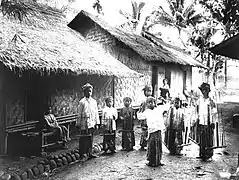
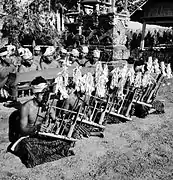 Angklung Players, Indonesia, 1949.
Angklung Players, Indonesia, 1949.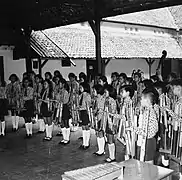 Angklung Orchestra, Indonesia in 1971.
Angklung Orchestra, Indonesia in 1971. Sundanese boys playing the angklung in 1918.
Sundanese boys playing the angklung in 1918.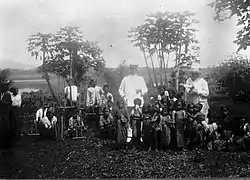 Children with angklung players at Lake Bagendit.
Children with angklung players at Lake Bagendit.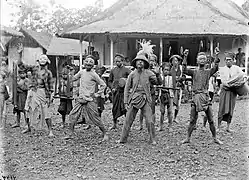 Angklung and dancers.
Angklung and dancers.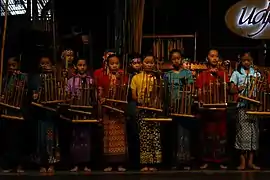 Playing Angklung.
Playing Angklung.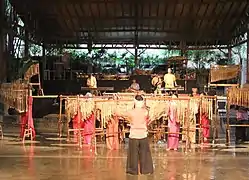 Angklung orchestra at Saung Angklung Udjo, Indonesia.
Angklung orchestra at Saung Angklung Udjo, Indonesia.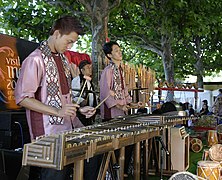
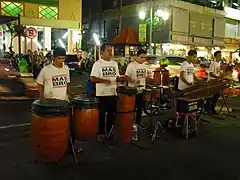 Angklung Toel performance in Malioboro street in Yogyakarta.
Angklung Toel performance in Malioboro street in Yogyakarta.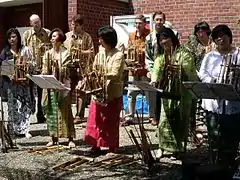 MKIF Angklung Group performance in Germany.
MKIF Angklung Group performance in Germany.
See also
References
- ""Indonesian Angklung", Inscribed in 2010 (5.COM) on the Representative List of the Intangible Cultural Heritage of Humanity". UNESCO. Retrieved 5 January 2021.
- Spiller, Henry (2004). Gamelan: The Traditional Sounds of Indonesia, Volume 1. ABC-CLIO. p. 140. ISBN 9781851095063.
Angklung has become a veritable symbol of Sundanese culture
- ""Indonesian Angklung", Inscribed in 2010 (5.COM) on the Representative List of the Intangible Cultural Heritage of Humanity". UNESCO. Retrieved 10 October 2014.
- "Angklung : Harmony in a Bamboo Orchestra". Archived from the original on 28 September 2014. Retrieved 2 October 2014.
- "Banten Angklung Buhun". Archived from the original on 2011-10-03. Retrieved 2011-08-19.
- Awi-Awi Mandiri, The Spirit of Angklung, 2018
- "Website Resmi Pemerintah Provinsi Banten". bantenprov.go.id. Archived from the original on Oct 2, 2011. Retrieved Jan 6, 2021.
- "Unesco to Declare Indonesia's Angklung World Heritage". The Jakarta Globe. October 8, 2018.
- "ANGKLUNG, Alat musik tradisional ini terbuat dari tabung-tabung bambu". Government of Purwakarta. Retrieved 5 January 2021.
- "Sejarah Angklung, Jenis, dan Cara Memainkan". cnnindonesia. Retrieved 5 January 2021.
- "Angklung Bungko". Government of West Java. Retrieved 6 January 2021.
- "Angklung Badud". Government of West Java. Retrieved 6 January 2021.
- "Angklung Buncis". Government of West Java. Retrieved 6 January 2021.
- "Angklung Buncis". Kementrian Pendidikan dan Kebudayaan. Retrieved 6 January 2021.
- "'Calung' Alat Musik yang Menghasilkan Harmoni Indah". Indonesia Kaya. Retrieved 6 January 2021.
- Ornstein, Ruby (1971). "The Five-Tone Gamelan Angklung of North Bali". Ethnomusicology. 15 (1): 71–80. doi:10.2307/850388. JSTOR 850388.
- Koh, Lay Tin (17 April 1999). "Angklung". National Library Board Singapore. Archived from the original on 14 October 2008. Retrieved 2 September 2009.
- Bayuni, Endy M. (July 10, 2011). "Washington DC shakes to angklung world record". The Jakarta Post. Archived from the original on July 12, 2011. Retrieved July 11, 2011.
Further reading
- Tenzer, Michael (1998). Balinese Music. Hong Kong: Periplus Eds. ISBN 9789625931692.
External links
| Wikimedia Commons has media related to Angklung. |
- Gamelan Sekar Jaya (excerpt about angklung) from Michael Tenzer's book Balinese Music
- Musical sample composed by I Nyoman Windha
- Saung Angklung Udjo
- Angklung Orchester Hamburg, Germany (2003/2004)
- Angklung Web Institute
- Lancaster Angklung Orchestra, Lancaster, UK
- Angklung Hamburg
- Keluarga Paduan Angklung SMA Negeri 3 Bandung

